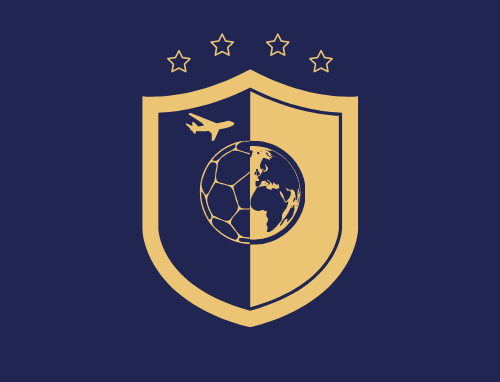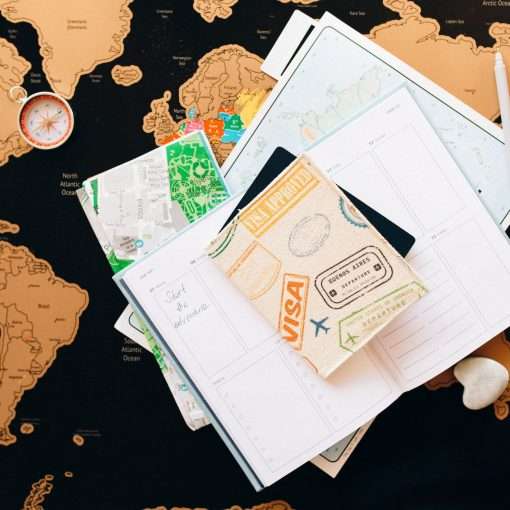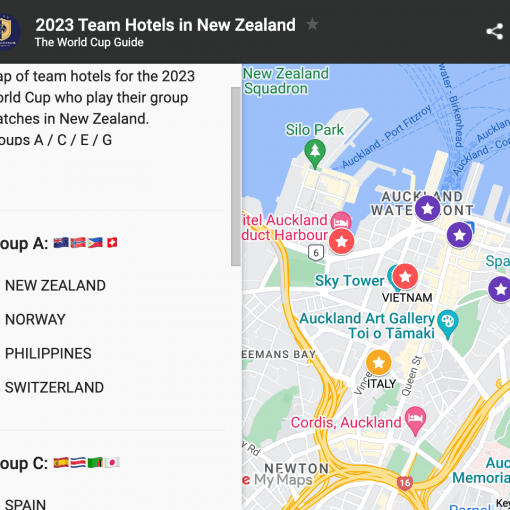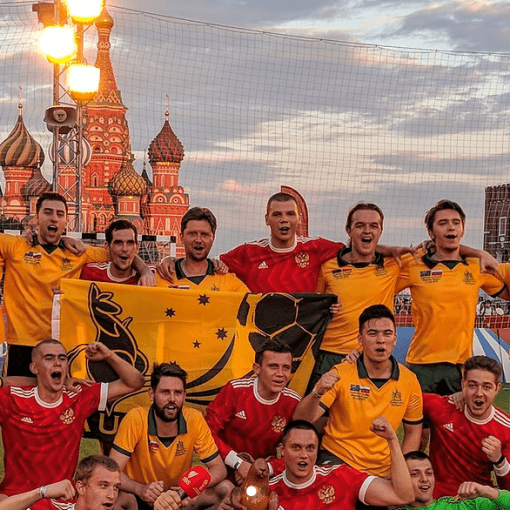The 2023 World Cup is split between Australia and New Zealand with 5 cities / 6 stadiums in Australia and 4 cities / 4 stadiums in New Zealand. Only Sydney, Australia will see games hosted in two different stadiums within the city limits.
See a list of the cities (including their First Nations names) below.
Australia

Brisbane (Meaanjin)
- One Sentence Summary:
- Brisbane is the capital city of Queensland and is known for its subtropical climate, beautiful beaches, and thriving arts and cultural scene, making it a lively and diverse destination.
- World Cup Climate:
- July and August are considered winter months in Brisbane, and temperatures during this time of year tend to be cool to mild.
- July average is around 21°C (70°F) to 10°C (50°F).
- August average is around 21°C (70°F) to 10°C (50°F).
- Rainfall is less common in Brisbane during the winter months
- Fun Fact:
- It is home to the world’s largest Koala Sanctuary, the Lone Pine Koala Sanctuary. The sanctuary is home to more than 130 koalas, as well as a range of other native Australian animals such as kangaroos, wallabies, and wombats. It is a popular attraction for tourists and offers many opportunities for visitors to get up close and personal with the animals, including the chance to hold and take photos with a koala. The sanctuary is also a conservation center, working to protect and preserve the koala population and their natural habitat.
- Population:
- Approximately 2.5 million people
- Professional men’s soccer team:
- Brisbane Roar FC, which plays in the A-League
- Professional women’s soccer team:
- Brisbane Roar FC, which plays in the W-League
- Stadium:
- Getting Around
- Public transportation system: TransLink
- Buses: Operate frequently and cover most areas of the city.
- Trains: Run on multiple lines and can be a quick way to get to the suburbs or outer areas of the city.
- Ferries: A scenic way to get around the city, with services operating on the Brisbane River.
- Bicycles: Yes, bike-friendly with cycling paths and rentals available
- Taxi or ride-sharing: Taxis, Uber, GoCatch, Ola
- Walking: Rated a 51 on Walk Score
- Public transportation system: TransLink
Adelaide (Tarntanya)
- One Sentence Summary:
- Adelaide is the capital city of South Australia and is known for its rich history, beautiful parklands, and its calendar full of festivals and events throughout the year, making it a vibrant and cultural destination.
- World Cup climate:
- July average is around 14°C (57°F) to 7°C (45°F).
- August average is around 14°C (57°F) to 7°C (45°F).
- During the winter months, Adelaide can experience cool, wet, and windy weather. It is important to dress warmly and bring rain gear if you are planning to visit Adelaide in July and August.
- Fun Fact:
- It is home to the world’s largest man-made green roof, which can be found at the Adelaide Convention Centre. The green roof covers an area of 7,000 square meters and is home to a range of native plants and wildlife. It helps to insulate the convention center, reduce stormwater runoff, and improve air quality, making it a sustainable and environmentally friendly feature of the city. The green roof is also a popular attraction for tourists and locals, offering panoramic views of the city and the surrounding parklands.
- Population:
- Approximately 1.4 million people
- Professional men’s soccer team:
- Adelaide United, which plays in the A-League
- Professional women’s soccer team:
- Adelaide United, which plays in the W-League
- Stadium:
- Getting Around
- Public transportation system: Adelaide Metro
- Buses: Operate frequently and cover most areas of the city.
- Trams: A convenient way to get around the city, with services running on several lines.
- Walking: Rated a 54 on Walk Score
- Taxi or ride-sharing: Taxis, Uber, GoCatch, Ola
- Bicycles: Can be rented from various locations and offer a healthy and environmentally-friendly way to get around.
- Public transportation system: Adelaide Metro
Melbourne (Naarm)
- One Sentence Summary:
- Melbourne is the capital city of Victoria and is known for its thriving arts and culture scene, beautiful parks and gardens, and its love of coffee and food, making it a sophisticated and cosmopolitan destination.
- World Cup Climate:
- July average is around 13°C (55°F) to 6°C (43°F).
- August average is around 13°C (55°F) to 6°C (43°F).
- During the winter months, Melbourne can experience cool, wet, and windy weather. It is important to dress warmly and bring rain gear if you are planning to visit Melbourne in July and August.
- Fun Fact:
- It is home to the largest tram network in the world. The Melbourne tram system covers more than 250 kilometers of track and serves more than 50 suburbs across the city. It is a popular and convenient form of public transportation for both locals and tourists and is a distinctive feature of the city’s landscape. The tram network is also a popular tourist attraction in its own right, with many tram routes offering scenic views of the city and its suburbs. Melbourne is also known for its love of coffee and its many popular cafés and coffee shops, which are often found alongside the tram tracks.
- Population:
- Approximately 5 million people
- Professional men’s soccer teams:
- Melbourne City FC and Melbourne Victory FC, both of which play in the A-League
- Professional women’s soccer teams:
- Melbourne City FC and Melbourne Victory FC, both of which play in the W-League
- Stadium:
- Getting Around
- Public transportation system: Public Transport Victoria (PTV)
- Trains, trams, or buses may be the most efficient option. Melbourne has an extensive network of public transportation that covers most areas of the city.
- Taxi or ride-sharing: Taxis, Uber, GoCatch, Ola
- Walking: Rated a 59 Walk Score
- Public transportation system: Public Transport Victoria (PTV)
Perth (Boorloo)
- One Sentence Summary:
- Perth is the capital city of Western Australia and is known for its sunny weather, beautiful beaches, and relaxed outdoor lifestyle, making it an ideal destination for those seeking a more laid-back Australian experience.
- World Cup Climate:
- July average is around 15°C (59°F) to 8°C (46°F).
- August average is around 16°C (61°F) to 8°C (46°F).
- During the winter months, Perth can experience cool, wet, and windy weather. It is important to dress warmly and bring rain gear if you are planning to visit Perth in July and August.
- Fun Fact:
- The city gets an average of eight hours of sunshine per day, making it a great destination for outdoor enthusiasts and those who love sunny weather, though winters can be wet. It is also home to many beautiful beaches and parks, as well as a thriving outdoor culture, with many opportunities for activities such as swimming, surfing, and exploring the surrounding natural environment.
- Population:
- Approximately 2.2 million people
- Professional men’s soccer team:
- Perth Glory, which plays in the A-League
- Professional women’s soccer team:
- Perth Glory, which plays in the W-League
- Stadium:
- Getting Around
- Public transportation system: Transperth
- Taxi or ride-sharing: Taxis, Uber, GoCatch, Ola
- Walking: Rated a 50 on Walk Score
Sydney (Gadigal)
- One Sentence Summary:
- Sydney is the largest city in Australia and is known for its iconic Opera House, beautiful harbor, and gorgeous beaches, making it a must-visit destination for tourists.
- World Cup Climate:
- July average is around 16°C (61°F) to 8°C (46°F).
- August average is around 16°C (61°F) to 8°C (46°F).
- During the winter months, Sydney can experience cool, wet, and windy weather. It is important to dress warmly and bring rain gear if you are planning to visit Sydney in July and August.
- Fun Fact:
- It is home to the world’s largest offshore island national park, the Sydney Harbour National Park. The park covers more than 20,000 hectares and includes a number of popular attractions such as the Sydney Opera House, Taronga Zoo, and the Sydney Harbour Bridge. It is also home to a range of diverse and unique flora and fauna, including over 140 species of birds and many threatened and endangered species. The park offers many opportunities for outdoor activities such as hiking, picnicking, and wildlife watching.
- Population:
- Approximately 5.3 million people
- Professional men’s soccer team:
- Sydney FC, which plays in the A-League
- Professional women’s soccer team:
- Sydney FC, which plays in the W-League
- Stadium(s):
- Getting Around
- Public transportation system: Transport for New South Wales (TfNSW)
- Trains, buses, ferries, or light rail may be the most efficient option. Sydney has an extensive network of public transportation that covers most areas of the city
- Walking: Rated a 64 on Walk Score
- Taxi or ride-sharing: Taxis, Uber, GoCatch, Ola
- Public transportation system: Transport for New South Wales (TfNSW)
New Zealand

Dunedin (Ōtepoti)
- One Sentence Summary:
- Dunedin is the second-largest city on the South Island of New Zealand and is known for its beautiful Victorian and Edwardian architecture, stunning natural surroundings, and rich cultural heritage, making it a unique and charming destination.
- World Cup Climate:
- July average is around 12°C (54°F) to 6°C (43°F).
- August average is around 13°C (55°F) to 6°C (43°F).
- During the winter months, Dunedin can experience cool, wet, and windy weather. It is important to dress warmly and bring rain gear if you are planning to visit Dunedin in July and August.
- Fun Fact:
- It is home to the world’s steepest residential street, Baldwin Street. Located in the suburb of North East Valley, Baldwin Street has an average gradient of 1 in 2.86 (19° or 35%) and a maximum gradient of 1 in 2.4 (25° or 46%) at its steepest point. The street is a popular attraction for tourists and is often used as a challenge for runners and fitness enthusiasts. It was recognized by the Guinness World Records as the steepest street in the world.
- Population:
- Approximately 120,000 people
- Professional men’s soccer team:
- N/A
- Professional women’s soccer team:
- N/A
- Stadium:
- Getting Around
- Public transportation system: Dunedin has a public transportation system that includes buses, which are operated by Go Bus Transport and Otago Regional Council.
- Taxi or ride-sharing: Taxis, Uber, Zoomy, Ola
- Biking: Dunedin has a number of dedicated bike paths and is generally considered to be a bike-friendly city. There are several bike rental companies in the city if you don’t have your own bike.
- Walking: While it is possible to walk around in Dunedin, the city is not particularly walkable compared to some other cities.
Auckland (Tāmaki Makaurau)
- One Sentence Summary:
- Auckland is the largest city in New Zealand and is known for its diverse population, beautiful harbor and beaches, and abundance of outdoor recreational opportunities, making it a vibrant and exciting destination.
- World Cup Climate:
- July average is around 14°C (57°F) to 9°C (48°F).
- August average is around 14°C (57°F) to 9°C (48°F).
- During the winter months, Auckland can experience cool, wet, and windy weather. It is important to dress warmly and bring rain gear if you are planning to visit Auckland in July and August.
- Fun Fact:
- It is known as the “City of Sails,” due to its large harbor and abundance of yachts and boats. Located on the North Island, Auckland is surrounded by the Hauraki Gulf and has a number of beautiful beaches and islands within easy reach, making it a popular destination for water sports and outdoor activities. The city is also home to the Sky Tower, which offers panoramic views of the city and the surrounding region from its observation deck.
- Population:
- Approximately 1.6 million people
- Professional men’s soccer team:
- Auckland City FC, which plays in the New Zealand Football Championship.
- Professional women’s soccer team:
- Auckland Football Federation, which plays in the New Zealand Football Championship.
- Stadium:
- Getting Around
- Public transportation system: Auckland has an extensive public transportation system that includes buses, trains, ferries, and light rail. Auckland Transport operates the system, known as AT, and it covers a wide area of the city.
- Taxi or ride-sharing: Taxis, Uber, Zoomy, Ola
- Biking: Auckland has a number of dedicated bike paths and is generally considered to be a bike-friendly city. There are several bike rental companies in Auckland that allow you to rent a bike for a few hours or for the day.
- Walking: It largely depends on what neighborhood you’re at within Auckland.
Hamilton (Kirikiriroa)
- One Sentence Summary:
- Hamilton is the largest city on the North Island of New Zealand and is known for its beautiful gardens and parklands, as well as its convenient location as a gateway to the wider Waikato region, making it a great base for exploring the surrounding area.
- World Cup Climate:
- July average is around 12°C (54°F) to 6°C (43°F).
- August average is around 13°C (55°F) to 6°C (43°F).
- During the winter months, Hamilton can experience cool, wet, and windy weather. It is important to dress warmly and bring rain gear if you are planning to visit Hamilton in July and August.
- Fun Fact:
- It is home to the largest public garden in the Southern Hemisphere, the Hamilton Gardens. The gardens cover more than 50 hectares and feature a range of themed gardens that showcase different styles and periods of garden design from around the world. These include the Italian Renaissance Garden, the Japanese Garden of Contemplation, and the Indian Char Bagh Garden, among others. The gardens are a popular attraction for both locals and tourists and offer a peaceful and relaxing escape from the hustle and bustle of city life.
- Population:
- Approximately 180,000 people
- Professional men’s soccer team:
- N/A
- Professional women’s soccer team:
- N/A
- Stadium:
- Getting Around
- Public transportation system: Hamilton has a public transportation system that includes buses, which are operated by Hamilton City Council and Go Bus Transport. The system covers a wide area of the city and offers several different bus routes to choose from.
- Taxi or ride-sharing: Taxis, Uber, Zoomy, Ola
- Biking: Hamilton has a number of dedicated bike paths and is a bike-friendly city.
- Walking: Depending on your location and destination, it may be possible to get around Hamilton by walking. The city has a number of pedestrian-friendly areas.
Wellington (Te Whanganui-a-Tara)
- One Sentence Summary:
- Wellington is the capital city of New Zealand and is known for its beautiful natural setting, rich culture and arts scene, and vibrant culinary scene, making it a sophisticated and lively destination.
- World Cup climate:
- July average is around 12°C (54°F) to 7°C (45°F).
- August average is around 12°C (54°F) to 6°C (43°F).
- During the winter months, Wellington can experience cool, wet, and windy weather. It is important to dress warmly and bring rain gear if you are planning to visit Wellington in July and August.
- Fun Fact:
- It is home to the world’s southernmost capital city. Located at the southern tip of the North Island, Wellington enjoys a mild and temperate climate, with average summer temperatures ranging from 15 to 25 degrees Celsius and average winter temperatures ranging from 5 to 15 degrees Celsius. This makes it a great destination for outdoor enthusiasts, with many opportunities for hiking, cycling, and exploring the nearby coastal and mountain regions.
- Population:
- Approximately 200,000 people
- Professional men’s soccer team:
- Wellington Phoenix FC, which plays in the Australian A-League.
- Professional women’s soccer team:
- Capital Football, which plays in the New Zealand Football Championship.
- Stadium:
- Getting Around
- Public transportation system: Wellington has a public transportation system that includes buses, trains, and ferries. Greater Wellington Regional Council operates the system known as Metlink.
- Taxi or ride-sharing: Taxis, Uber, Zoomy, Ola
- Biking: Wellington has a number of dedicated bike paths and is generally considered to be a bike-friendly city. There are several bike rental companies in Wellington that allow you to rent a bike for a few hours or for the day.
- Walking: Wellington is the most walkable city in New Zealand but still falls short of other big cities around the world.




